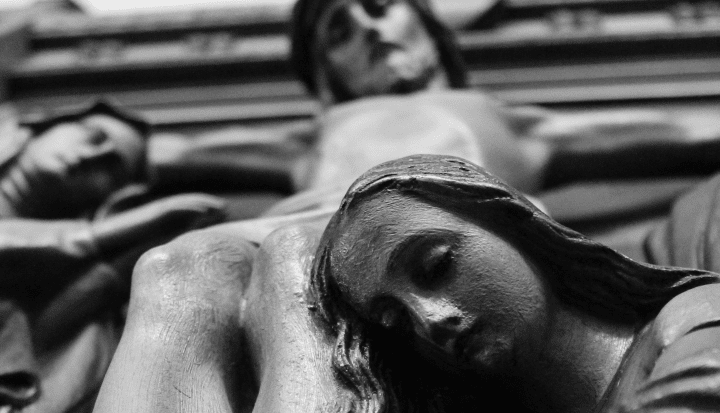Mary Magdalene, a figure both enigmatic and essential, is often remembered for the demons she was freed from, an event only briefly touched upon in the scriptures but expansive in its cultural and historical implications. This single narrative arc has spiraled into various interpretations and misrepresentations, notably her wrongful identification as a prostitute, a misconception popularized in the Middle Ages and not corrected until much later by the Catholic Church.
Mary’s steadfastness is one of her most defining characteristics. While many of Jesus’s disciples fled in his final moments, Mary Magdalene stayed. She witnessed his crucifixion, attended his burial, and was one of the first to find his tomb empty, confronting the angelic announcement of Jesus’s resurrection. Her devotion culminated in a profound moment when she became the first to see the risen Christ. Her story in the canonical gospels is rich with detail and implication, marked by her presence at some of the most critical moments in the narrative of Jesus’s life and death.
Early Biblical Mentions
Mary Magdalene emerges in the gospels of Matthew and Luke, not merely as a peripheral figure but as a pivotal one, with her story intricately woven into the fabric of Christ’s ministry. In Matthew 27:56, she is a silent witness to the crucifixion, her presence speaking volumes of her devotion. Meanwhile, Luke 8:2 sheds light on her profound personal transformation, detailing her healing from seven demons, a symbol of complete spiritual renewal.
Her appearances, sparse yet significant, paint a picture of a woman deeply transformed by her encounter with Christ. Each mention is not just a historical note but a narrative arc, leading from despair to devotion, from marginalization to being central in the Christian story of resurrection and hope. Her initial depiction as a healed and devoted follower sets a precedent for understanding her role – not as a mere footnote, but as a testament to the transformative power of divine intervention and unconditional faith.
As the story unfolds, Mary Magdalene’s journey reflects the broader themes of redemption and discipleship that are central to the Christian faith. Her life, marked by moments of deep personal and spiritual upheaval, invites believers to look beyond the surface, challenging long-held beliefs and embracing a more profound, nuanced understanding of redemption. Her early mentions in the Bible serve as a prologue to a life that would forever be remembered for its close association with Jesus and its impact on Christian history.
Misconceptions and Mysteries
Mary Magdalene’s story has been veiled in misconceptions, often overshadowed by a historical mix-up between her and other women in biblical narratives. For centuries, she was mistakenly identified as the sinful woman who anointed Jesus’ feet, leading to an erroneous yet persistent label of her as a prostitute. This profound mislabeling, deeply ingrained in cultural and religious discourse, was not a mere error but a reflection of how women’s roles and reputations were shaped and distorted by the societal and theological norms of the time.
The mystery surrounding her true identity and role became a subject of speculation and debate. Art, literature, and later media would often depict her as a penitent sinner, overshadowing her actual biblical portrayal as a devoted disciple. This misconception was so pervasive that it wasn’t until 1969 that the Catholic Church officially clarified that Mary Magdalene was not the sinful woman mentioned in Luke 7, disentangling her from centuries of misrepresentation.
The journey to reclaim Mary Magdalene’s true identity from the layers of myth and misconception reflects the broader challenge of interpreting historical texts within their cultural and societal context. It underscores the necessity of critical examination and the continuous effort to understand the complex interplay between scripture, societal norms, and historical interpretation. Her story, therefore, is not just about her as an individual but about the broader dynamics of cultural and religious understanding and the quest for truth in historical religious narratives.
Unwavering Devotion
Mary Magdalene’s unwavering devotion, as depicted in the Bible, showcases her as a central figure in the narrative of Jesus’s ministry, particularly during his crucifixion, burial, and after his resurrection. Her fidelity is demonstrated through her presence at the cross, a scene that paints a vivid picture of her emotional and spiritual fortitude amidst despair and sorrow. Furthermore, her visit to the tomb, and being the first to witness the resurrected Jesus, underscores her role as a pivotal witness to these cornerstone events in Christian faith. Her journey, marked by steadfastness and hope, offers a profound example of commitment that continues to inspire faith and devotion across generations.
The Aftermath and Apocryphal Tales
Post-resurrection, the Bible offers little on Mary’s life, yet various traditions and non-canonical texts provide glimpses into her later years. Some suggest she traveled, spreading the Christian message, while others claim she lived out her days in quiet contemplation. These accounts, while not verified, contribute to the rich tapestry of her legacy.
Modern Reinterpretation and Influence
Today, Mary Magdalene is revered as a saint and a symbol of redemption and grace. Her journey from a tormented past to a dedicated follower of Jesus continues to inspire and resonate with many, showcasing the transformative power of faith and the enduring human spirit.
Beyond the gospels, her life is shrouded in mystery. Tradition and legend take her story beyond the Bible, with some accounts claiming she ended her days in Ephesus with Mary, the mother of Jesus, or traveled as far as Southern France. Whatever her later life held, her impact as a disciple and witness remains a compelling aspect of early Christian history.
Mary Magdalene’s journey from demoniac to disciple, her presence at the crucifixion, and her encounter with the resurrected Jesus make her one of the most discussed and debated figures in Christian theology. Her story is a blend of biblical facts, cultural misreadings, and spiritual symbolism, reflecting the complex nature of biblical interpretation and the enduring intrigue of her character.
Conclusion
As we revisit her story, we uncover layers of historical, theological, and cultural significance. Mary Magdalene’s narrative, from the first biblical mention to her lasting impact, invites us to reconsider our understanding of her role in Christian history and to appreciate the profound depth of her character and journey. Her legacy, marked by misinterpretation, devotion, and mystery, offers a fascinating glimpse into the early Christian era and the enduring power of personal transformation.


